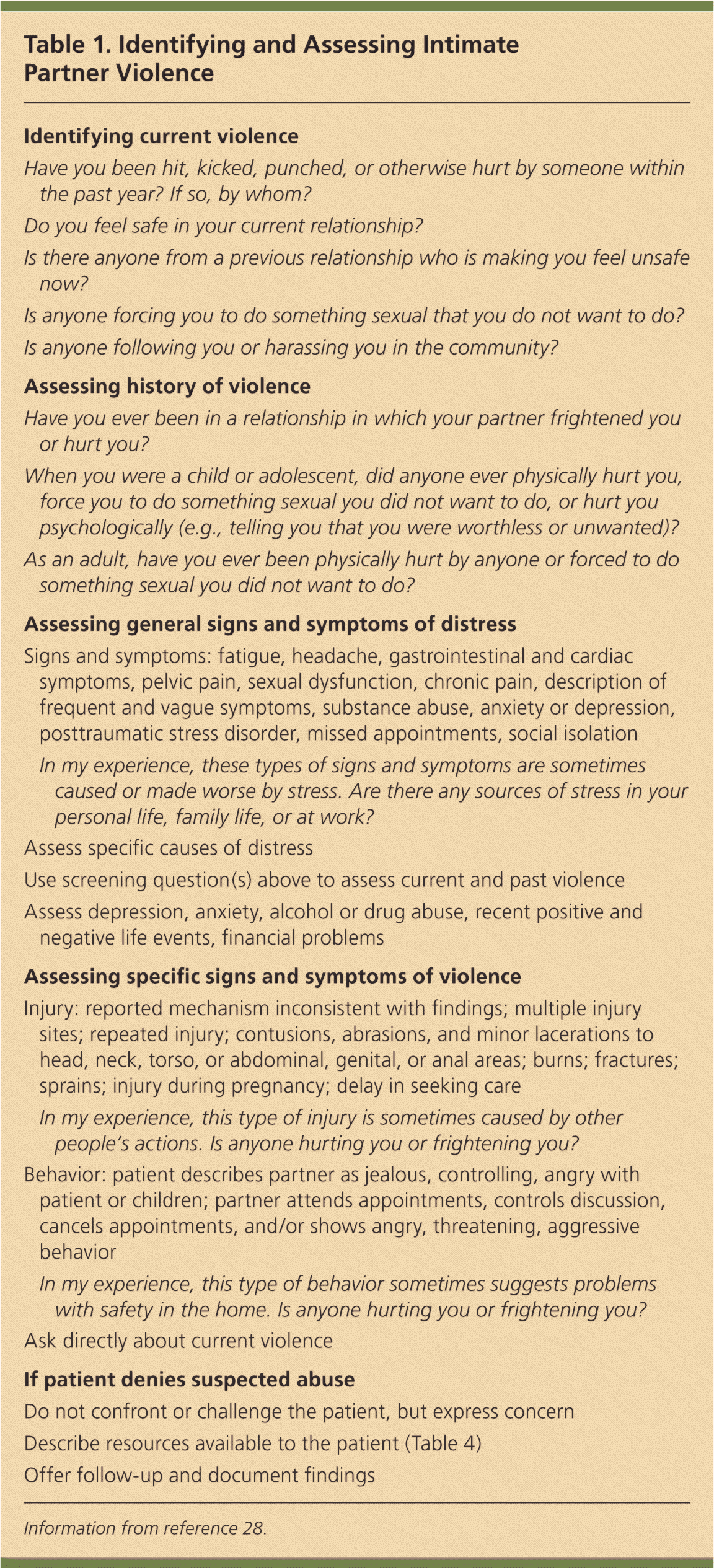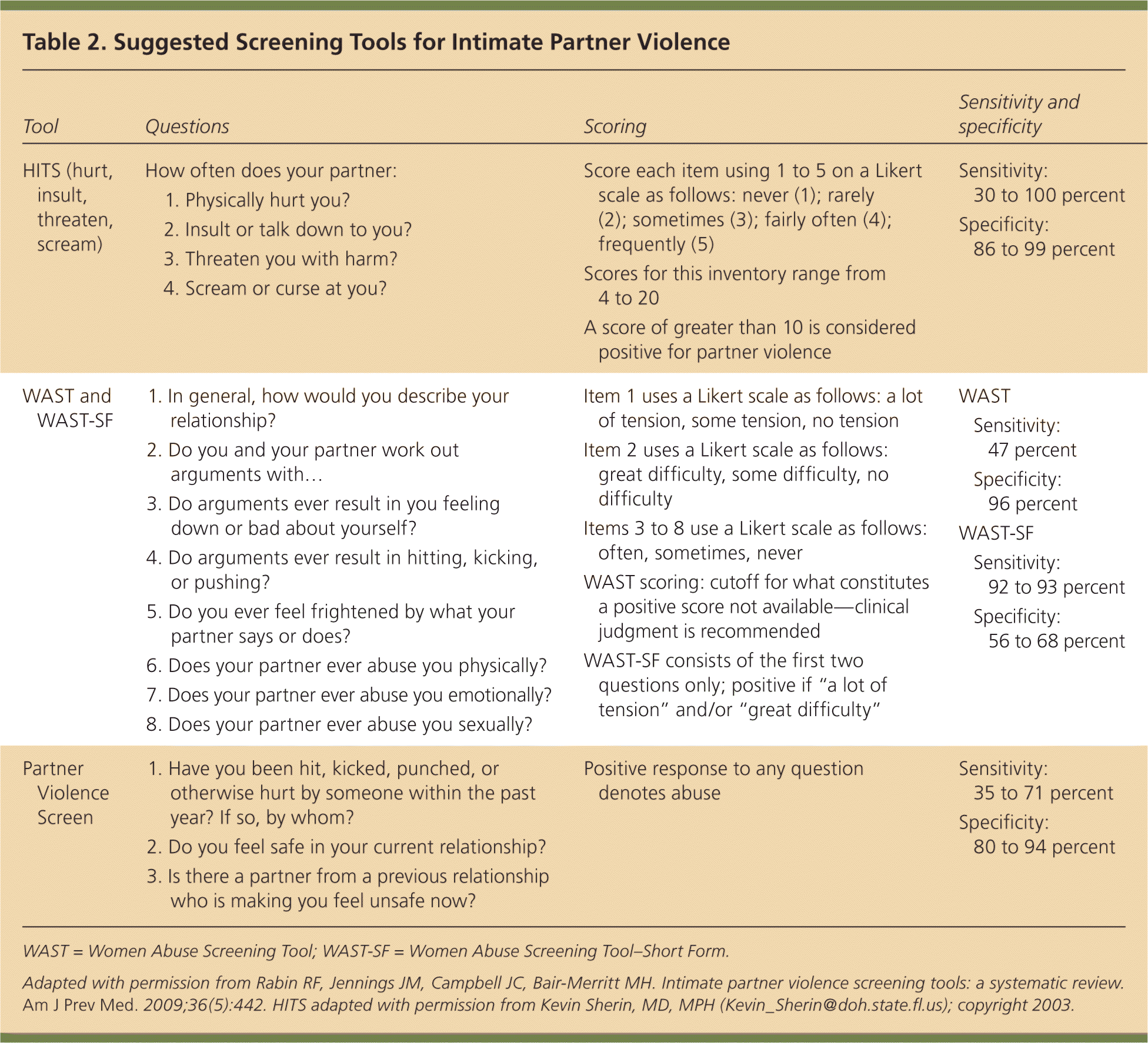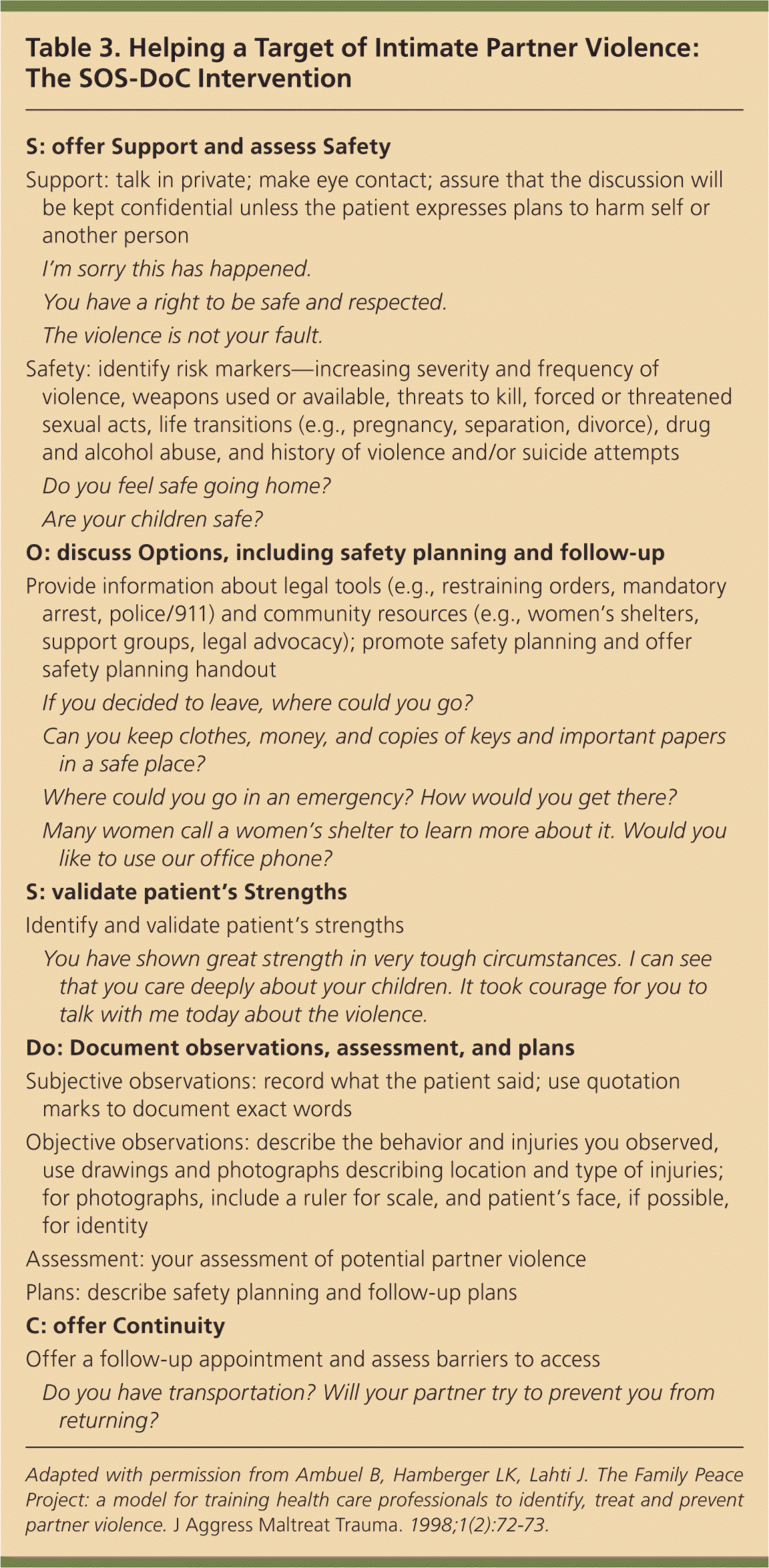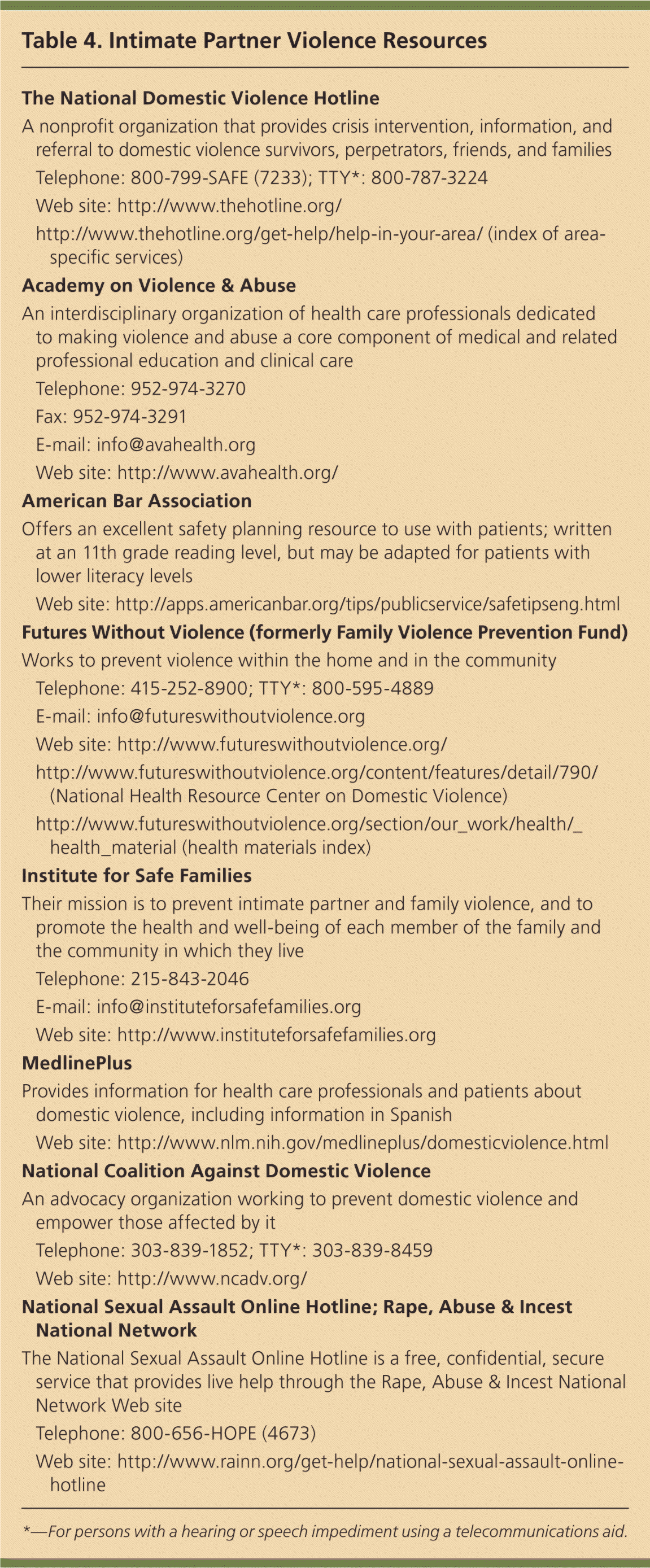
A more recent article on intimate partner violence is available.
Am Fam Physician. 2011;83(10):1165-1172
Related letter: Qualitative Benefits of Screening for Intimate Partner Violence
Patient information: See related handout on partner violence, written by the authors of this article.
Author disclosure: Nothing to disclose.
Intimate partner violence is a common source of physical, psychological, and emotional morbidity. In the United States, approximately 1.5 million women and 834,700 men annually are raped and/or physically assaulted by an intimate partner. Women are more likely than men to be injured, sexually assaulted, or murdered by an intimate partner. Studies suggest that one in four women is at lifetime risk. Physicians can use therapeutic relationships with patients to identify intimate partner violence, make brief office interventions, offer continuity of care, and refer them for subspecialty and community-based evaluation, treatment, and advocacy. Primary care physicians are ideally positioned to work from a preventive framework and address at-risk behaviors. Strategies for identifying intimate partner violence include asking relevant questions in patient histories, screening during periodic health examinations, and case finding in patients with suggestive signs or symptoms. Discussion needs to occur confidentially. Physicians should be aware of increased child abuse risk and negative effects on children's health observed in families with intimate partner violence. Physicians also should be familiar with local and national resources available to these patients.
Domestic or intimate partner violence (IPV) is a common social and behavioral issue with negative effects on health. This article defines domestic violence as a pattern of assaultive and coercive behaviors, including physical injury, psychological abuse, sexual assault, enforced social isolation, stalking, deprivation, intimidation, and threats.1 Domestic violence includes abuse of older persons, children, and intimate partners. IPV is a type of domestic violence in which the perpetrator is, was, or wishes to be involved in an intimate or dating relationship with the adult or adolescent survivor. This article uses the term “survivor” to describe a partner in an intimate relationship who has been or is currently subjected to violence or abuse.
The perpetrator's behavior aims to establish control over or punish the survivor. Most IPV research has focused on male perpetrators with female survivors in heterosexual relationships. In reality, IPV is a complex disorder with a spectrum ranging from unidirectional perpetrator-survivor couples to mutually aggressive couples in which the survivor of abuse can be difficult to differentiate from the perpetrator. IPV occurs in all types of relationships, including gay, lesbian, bisexual, and transgender relationships.
| Clinical recommendation | Evidence rating | References | Comments |
|---|---|---|---|
| Physicians should discuss IPV and family violence with their patients in a routine, nonjudgmental manner. | C | 24, 26 | American Academy of Family Physicians' statement on the role of the family physician in the identification and treatment of family violence24 |
| The U.S. Preventive Services Task Force found insufficient evidence to support IPV screening. | C | 35 | — |
| There is no evidence of harm in screening for IPV. | B | 37 | Randomized controlled trial of 6,500 family medicine patients in Canada |
| The Partner Violence Screen is a three-question screening tool with a high specificity. | C | 43, 44 | — |
Epidemiology and Impact
In the United States, an estimated 25 percent of women and 7.6 percent of men report being targets of IPV during their lifetimes.2 From conservative estimates, 14 to 35 percent of adult female patients in emergency departments and 12 to 23 percent in family medicine offices report experiencing IPV within the previous year.3–7
In the United States, approximately 1.5 million women and 834,700 men annually are raped and/or physically assaulted by an intimate partner.2 Women experience more severe forms of IPV than men and are more likely to be severely injured, sexually assaulted, or murdered.2 Of the estimated 4.8 million intimate partner rapes and physical assaults perpetrated against women annually, 2 million result in physical injury to the woman, with about 552,000 requiring medical treatment.2 Of the estimated 2.9 million intimate partner physical assaults perpetrated against men annually, 581,391 result in physical injury.2 Costs of IPV are estimated to exceed $5.8 billion annually, of which $4.1 billion are for direct medical and mental health services.8
IPV survivors have a 1.6- to 2.3-fold increase in health care use compared with nonabused peers.8,9 Prospective case-control and observational studies suggest a strong relationship between exposure to IPV and a wide variety of negative physical, mental, emotional, social, and financial consequences.10–18 IPV survivors report a poorer sense of physical and mental health compared with women who never experienced IPV.11 Examples of physical injuries from IPV include contusions, broken bones, and lacerations. Some IPV-associated injuries may be fatal.
Women exposed to IPV also have higher rates of gynecologic, gastrointestinal, urinary, musculoskeletal, and neurologic symptoms, along with increased rates of sexually transmitted infections, chronic pain, elective abortion, and poor pregnancy outcomes.12–15 Psychological consequences of abuse are as important as the physical injuries. Abused persons may develop posttraumatic stress disorder and are more likely than nonabused persons to have depression, attempt suicide, misuse alcohol or drugs, and abuse their children.14,16–18
Children living in households with IPV are at increased risk of maltreatment and lifelong poor health. Estimates suggest that child abuse occurs in up to one-half of households with IPV.19 Children exposed to IPV have increased rates of behavioral and physical health problems, including depression, anxiety, violence toward peers, attempted suicide, abuse of drugs and alcohol, running away from home, risky sexual behavior, and committing sexual assault.20–23 Mounting evidence demonstrates that children who grow up in households with substantial relational dysfunction, even without any abuse directed toward the child, have higher mortality rates and increased morbidity as adults.10
Role of the Family Physician
Family physicians have an important role in IPV detection, prevention, and intervention because of their unique relationship with patients.24 Many patients are involved in violent relationships—in addition to the 12 to 23 percent of female family medicine patients who report experiencing IPV, 13.5 percent of male patients report perpetrating minor violence (e.g., throwing, pushing, slapping) within the past 12 months, and 4.2 percent report at least one episode of severe violence (e.g., kicking, beating, threatening to use or using a knife or gun).3–5,25 High-quality evidence shows that patients welcome IPV questioning and screening when done in a nonjudgmental, respectful manner.26 It is important to consider cultural influences and the unique dynamics of special populations (e.g., lesbian, gay, bisexual, transgender, older couples, immigrant populations). A patient-centered framework for physicians to identify and address IPV includes awareness, identification, intervention, and prevention.
AWARENESS
Most patients will not spontaneously discuss being the survivor of IPV, yet want physicians to ask them about the topic in a supportive and confidential manner.26 Incorporating a violence history into routine history taking can identify IPV and build the physician-patient relationship. Appropriate inquiry creates a safe space for the abused patient to discuss health consequences and provides an opportunity for education about healthy relationships with all patients. Routine inquiry also provides important insights into the local prevalence of violence. Many experts suggest using a funneling technique for interviewing patients that involves moving from broad, less threatening questions to addressing specific behaviors. It is possible to screen for perpetration and victimization simultaneously by using parallel questions.27 Beginning with questions about victimization has less potential to make patients defensive about responding. Table 1 provides examples of questions to obtain a violence history.28

| Identifying current violence | |
| Have you been hit, kicked, punched, or otherwise hurt by someone within the past year? If so, by whom? | |
| Do you feel safe in your current relationship? | |
| Is there anyone from a previous relationship who is making you feel unsafe now? | |
| Is anyone forcing you to do something sexual that you do not want to do? | |
| Is anyone following you or harassing you in the community? | |
| Assessing history of violence | |
| Have you ever been in a relationship in which your partner frightened you or hurt you? | |
| When you were a child or adolescent, did anyone ever physically hurt you, force you to do something sexual you did not want to do, or hurt you psychologically (e.g., telling you that you were worthless or unwanted)? | |
| As an adult, have you ever been physically hurt by anyone or forced to do something sexual you did not want to do? | |
| Assessing general signs and symptoms of distress | |
| Signs and symptoms: fatigue, headache, gastrointestinal and cardiac symptoms, pelvic pain, sexual dysfunction, chronic pain, description of frequent and vague symptoms, substance abuse, anxiety or depression, posttraumatic stress disorder, missed appointments, social isolation | |
| In my experience, these types of signs and symptoms are sometimes caused or made worse by stress. Are there any sources of stress in your personal life, family life, or at work? | |
| Assess specific causes of distress | |
| Use screening question(s) above to assess current and past violence | |
| Assess depression, anxiety, alcohol or drug abuse, recent positive and negative life events, financial problems | |
| Assessing specific signs and symptoms of violence | |
| Injury: reported mechanism inconsistent with findings; multiple injury sites; repeated injury; contusions, abrasions, and minor lacerations to head, neck, torso, or abdominal, genital, or anal areas; burns; fractures; sprains; injury during pregnancy; delay in seeking care | |
| In my experience, this type of injury is sometimes caused by other people's actions. Is anyone hurting you or frightening you? | |
| Behavior: patient describes partner as jealous, controlling, angry with patient or children; partner attends appointments, controls discussion, cancels appointments, and/or shows angry, threatening, aggressive behavior | |
| In my experience, this type of behavior sometimes suggests problems with safety in the home. Is anyone hurting you or frightening you? | |
| Ask directly about current violence | |
| If patient denies suspected abuse | |
| Do not confront or challenge the patient, but express concern | |
| Describe resources available to the patient (Table 4) | |
| Offer follow-up and document findings | |
IDENTIFICATION
Gaps in evidence to support clinical guidelines, coupled with varying recommendations by professional organizations, have slowed development of uniform practice in IPV screening and identification. Considering that family physicians are expected to provide a range of health promotion and screening services, IPV screening may be omitted because of competing demands or other barriers.29,30 The American Academy of Family Physicians states that all family physicians should be alert for physical and behavioral signs and symptoms associated with abuse or neglect,24 but concludes that insufficient evidence exists to recommend for or against IPV screening.31 The American Academy of Pediatrics recommends either routine inquiry, or inquiry when there is clinical suspicion of IPV.32 The American Medical Association33 and the American Congress of Obstetricians and Gynecologists34 recommend routine inquiry about IPV with all patients.
The most recent U.S. Preventive Services Task Force review found insufficient evidence to support routine IPV screening.35 Although the review recognized the high prevalence of IPV and negative health associated with IPV exposure, it noted a paucity of randomized controlled trials (RCTs) demonstrating that screening benefits patients and does not cause harm.35 Critics of the review emphasize that its criteria eliminated evidence from more than 750 non-RCT studies on screening and 650 studies on intervention in reaching conclusions on IPV.36
Several recent studies have added to the knowledge about IPV screening. A large RCT of IPV screening in primary care and emergency department settings throughout Ontario, Canada, followed systematically screened women and control participants for 18 months.37 The study demonstrated that screening did not result in harm to participants, but also did not show benefit. There was not a significant difference in measures of abuse and quality of life in screened versus nonscreened women. However, design limitations, participant attrition, and missing data mandate caution in interpreting results from this study. Other recent RCTs have demonstrated benefit from IPV interventions, including multidisciplinary and cognitive-behavioral approaches.38–41
Several screening protocols and instruments have been designed for identifying IPV in clinical settings.42–44 Commonly used screening instruments range from three to eight questions on safety and coercion, as well as physical, sexual, and emotional abuse.43 The single question “Do you feel safe at home?” has a sensitivity of only 8.8 percent and a specificity of 91.2 percent, suggesting that more detailed screening questions are needed.45 Table 2 describes characteristics of commonly used screening instruments.43

INTERVENTION
Physicians should offer support to patients who report past or current IPV.24 Statements such as “no person deserves to be abused,” and “you have a right to be safe and respected,” communicate support and validation of concern. Physicians should assess the patient's immediate safety and assist her or him in formulating a safety plan. Many patients disclose IPV as violence escalates. Failure to identify a changing situation may result in harm to the person being abused. Physicians should refer patients exposed to IPV to community-based treatment and advocacy programs, and provide close clinical follow-up. The SOS-DoC framework (S—offer support and assess safety; O—discuss options; S—validate patient's strengths; Do—document observations, assessment, and plans; C—offer continuity) can guide physician response to IPV (Table 3).28 National resources are available by Internet and telephone, and some provide local resources by zip code (Table 4). Mandatory reporting laws vary by state, mechanism of reporting, and age of patient. Many health systems maintain policies regarding care for patients exposed to IPV. Physicians need to be familiar with state laws and health system policies.


| The National Domestic Violence Hotline | |
| A nonprofit organization that provides crisis intervention, information, and referral to domestic violence survivors, perpetrators, friends, and families | |
| Telephone: 800-799-SAFE (7233); TTY*: 800-787-3224 | |
| Web site: http://www.thehotline.org/ | |
| http://www.thehotline.org/get-help/help-in-your-area/ (index of area-specific services) | |
| Academy on Violence & Abuse | |
| An interdisciplinary organization of health care professionals dedicated to making violence and abuse a core component of medical and related professional education and clinical care | |
| Telephone: 952-974-3270 | |
| Fax: 952-974-3291 | |
| E-mail: info@avahealth.org | |
| Web site: http://www.avahealth.org/ | |
| American Bar Association | |
| Offers an excellent safety planning resource to use with patients; written at an 11th grade reading level, but may be adapted for patients with lower literacy levels | |
| Web site: http://apps.americanbar.org/tips/publicservice/safetipseng.html | |
| Futures Without Violence (formerly Family Violence Prevention Fund) | |
| Works to prevent violence within the home and in the community | |
| Telephone: 415-252-8900; TTY*: 800-595-4889 | |
| E-mail: info@futureswithoutviolence.org | |
| Web site: http://www.futureswithoutviolence.org/ | |
| http://www.futureswithoutviolence.org/content/features/detail/790/ (National Health Resource Center on Domestic Violence) | |
| http://www.futureswithoutviolence.org/section/our_work/health/_health_material (health materials index) | |
| Institute for Safe Families | |
| Their mission is to prevent intimate partner and family violence, and to promote the health and well-being of each member of the family and the community in which they live | |
| Telephone: 215-843-2046 | |
| E-mail: info@instituteforsafefamilies.org | |
| Web site: http://www.instituteforsafefamilies.org | |
| MedlinePlus | |
| Provides information for health care professionals and patients about domestic violence, including information in Spanish | |
| Web site: http://www.nlm.nih.gov/medlineplus/domesticviolence.html | |
| National Coalition Against Domestic Violence | |
| An advocacy organization working to prevent domestic violence and empower those affected by it | |
| Telephone: 303-839-1852; TTY*: 303-839-8459 | |
| Web site: http://www.ncadv.org/ | |
| National Sexual Assault Online Hotline; Rape, Abuse & Incest National Network | |
| The National Sexual Assault Online Hotline is a free, confidential, secure service that provides live help through the Rape, Abuse & Incest National Network Web site | |
| Telephone: 800-656-HOPE (4673) | |
| Web site: http://www.rainn.org/get-help/national-sexual-assault-online-hotline | |
Patients who deny IPV may not feel comfortable disclosing their experience or may not connect their personal situation with the questions asked. When patients deny IPV, the physician should provide education—noting that IPV affects the health of its survivors, perpetrators, and children who witness it—and state openness to discussing any concerns about IPV at future visits. Routine inquiry may enable patients to seek help in the future. Patients not in a violent relationship may share information with a friend and thus raise community awareness.
Inappropriate responses to an IPV disclosure may result in harm. It is important to make a safety and lethality assessment 46,47; listen to the patient's cues in establishing a safety plan; never discuss IPV with children or the perpetrating partner present; exercise caution regarding couples counseling, which is contraindicated when active violence, intimidation, fear, or control in the relationship is present; and avoid insisting that the patient leave her or his partner, because separation often escalates danger. The patient needs support in decisions about leaving or staying, and maintaining safety.
PREVENTION
Although evidence of effective primary prevention strategies is lacking, physicians may consider a variety of options. By displaying posters and brochures, the physician's office can provide educational messages about IPV and healthy relationships. Brochures appropriate for men, women, and adolescents can be offered routinely at health maintenance examinations. Education about healthy relationships adds a positive dimension to the clinical response to IPV. Identifying IPV has the potential to improve outcomes and prevent future incidents of abuse. Primary prevention strategies are needed to better support physicians in identifying and treating perpetrators.27
Role of the Health Care System
Achieving sustained improvements in the primary care response to IPV has proven elusive. Educating physicians and other clinical staff produces temporary improvements that are not sustained. In complex health care systems, individual effort alone does not maintain change. The RADAR protocol represents one of the earliest efforts to systematically address IPV in the clinical environment.48 The mnemonic RADAR consists of: routinely screen for IPV; ask direct questions; document findings; assess safety; and respond, review options, and refer.
Routine screening suggests screening during periodic health encounters (e.g., well-adult examinations, prenatal and postpartum visits), as well as when patients present with signs or symptoms that may indicate IPV exposure. Appropriate documentation can support patient advocacy because physician documentation of IPV is an exception to hearsay in many legal situations. Use of a body map can help in describing injuries and providing forensic documentation. These are schematic representations of the body that allow physicians to record the location of cuts, bruises, burns, and other injuries. An example is available at http://www.endabuse.org/userfiles/file/Maternal_Health/Body%20Map%20Consensus%5B1%5D.pdf. During the routine social history, integrating IPV inquiry along with items such as substance use, smoking, and seat belt use helps to establish the issue of IPV as a health care priority.
Recent research has demonstrated several systems strategies that improve identification of IPV, including validated patient self-report questionnaires, computerized screening, prompts in the electronic health record or on the paper chart, and continuous quality improvement.49 Some progressive models of screening and intervention use a team-based approach and quality improvement methods similar to the chronic care model to create sustained and cost-effective improvements.50
Data Sources: PubMed and Medline searches were completed using standard MeSH terms, including domestic violence, spouse abuse, battered women, prevalence, health knowledge attitudes and practice, adult, mass screening, questionnaires, mandatory reporting, health status, family practice, family health, physician-patient relations, referral and consultation, mental disorders, stress, psychological, women's health, and humans. Search date: March 2010. The search strategy was augmented by an evidence summary sent by American Family Physician.
